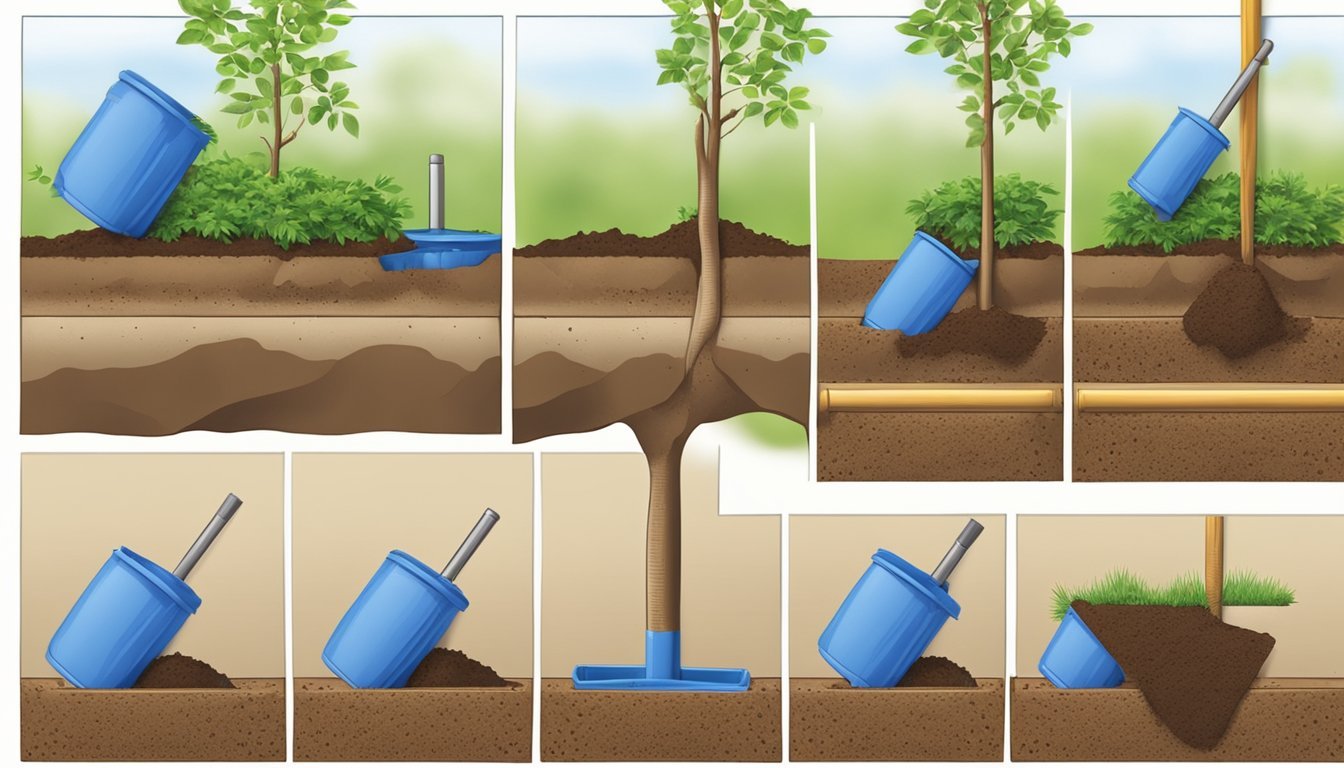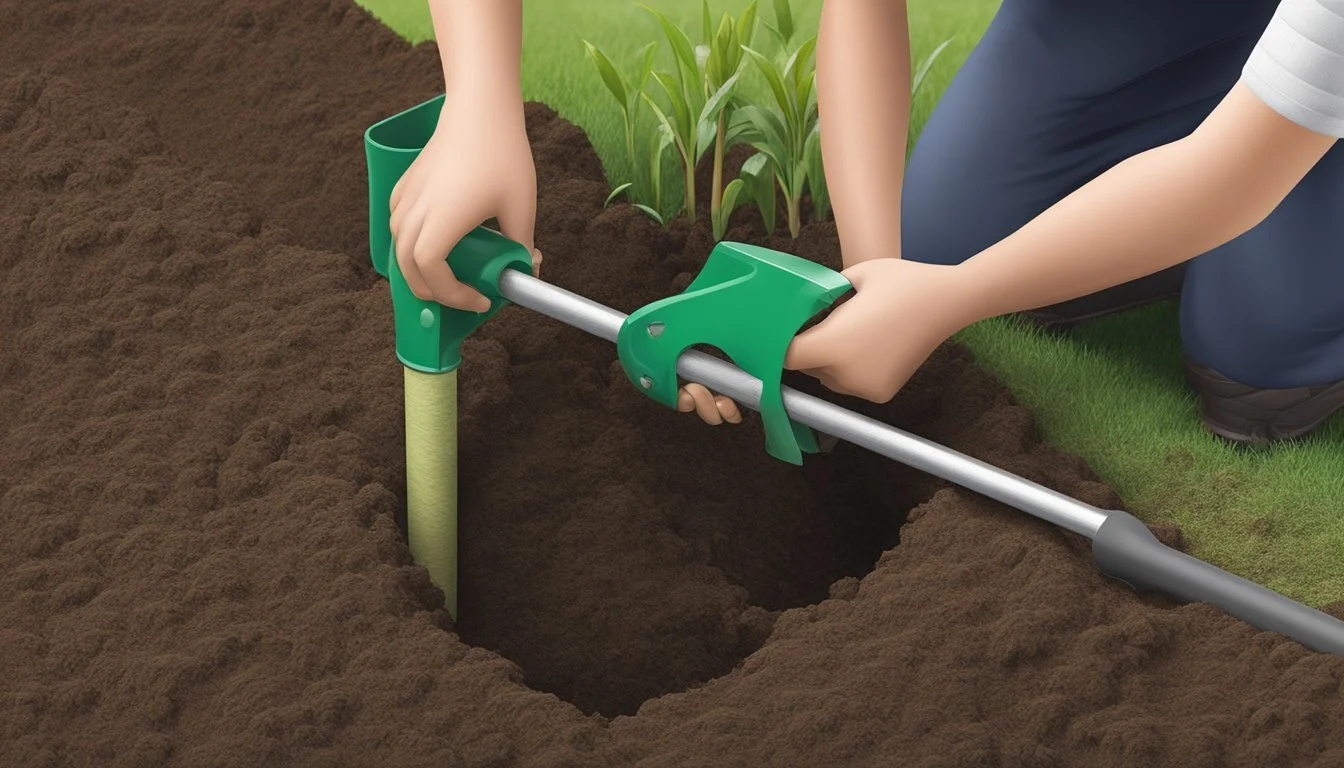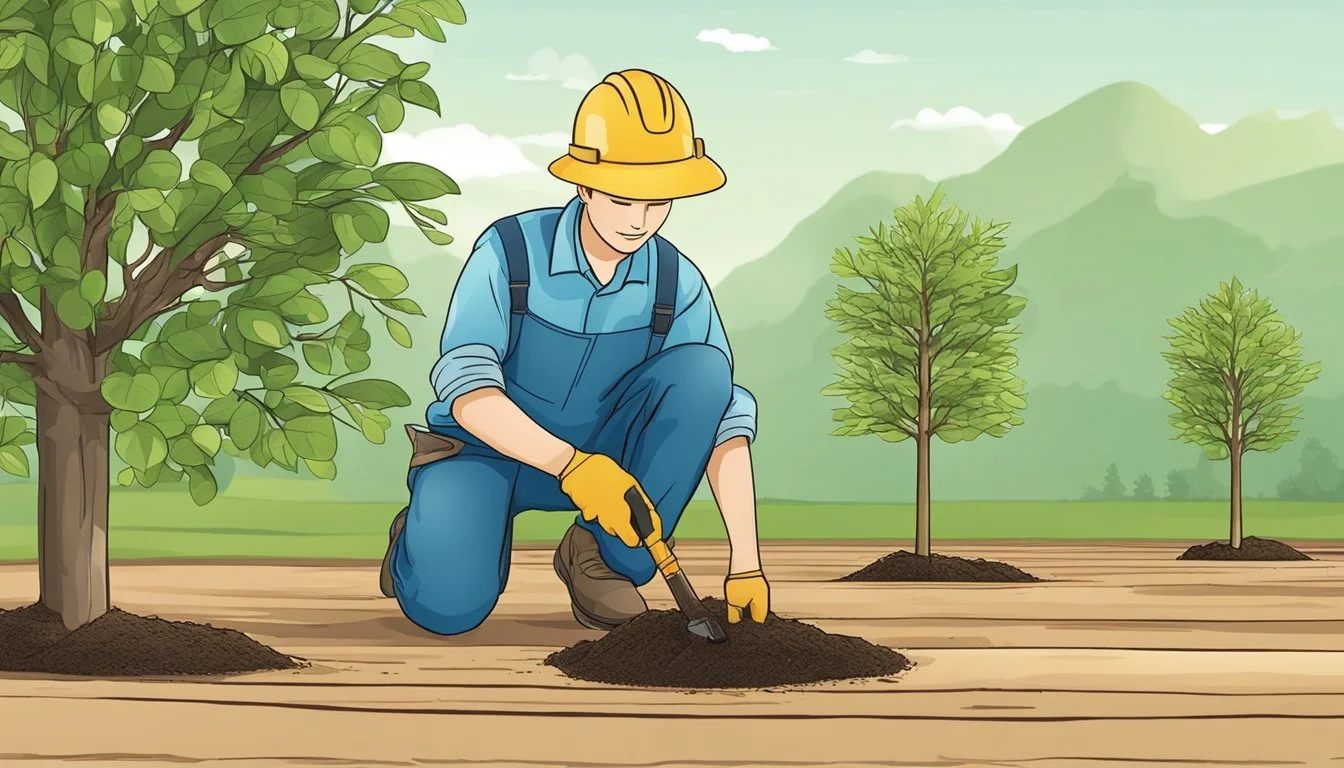The Ultimate Guide to Using a Tree Planting Bar
Master Efficient Tree Seedling Plantation on Your Homestead
A tree planting bar, commonly known as a dibble bar, is an essential tool for anyone looking to establish a new growth of trees efficiently and economically. This specialized piece of equipment streamlines the planting process, allowing the user to quickly create holes in the soil and insert the seedlings. Afforestation and reforestation projects on a homestead can benefit greatly from a dibble bar due to its effective design. It is particularly useful for planting a wide range of tree species, as it promotes rapid seedling establishment and stronger root systems by ensuring that the young trees are planted at the correct depth.
The dibble bar's simplicity is at the heart of its prolific use in planting initiatives. It consists of a T-shaped handle on a steel bar that ends in a wedge or blade, typically tapering to a point, which is pressed into the ground to create a planting hole. This method is advantageous over traditional spades or shovels as it allows for more precision and less disturbance to the surrounding soil. Its efficiency makes it a preferred choice for homesteaders aiming to cover larger areas or those participating in community-driven reforestation efforts where hundreds, if not thousands, of trees need to be planted.
Understanding the proper use of a dibble bar is crucial for the successful establishment of new trees. The user must ensure not only that the seedling is placed correctly in the hole created by the bar but also that the surrounding soil is appropriately compacted to eliminate air pockets, which can be detrimental to root growth. With the correct technique, the dibble bar can significantly increase the survival rate of planted seedlings, supporting a thriving forest ecosystem on any homestead.
Understanding the Dibble Bar
The dibble bar is a specialized tool for planting both bare-root and containerized seedlings quickly and effectively. Its simple design and use make it an essential tool for efficient afforestation and reforestation projects.
History and Design
The dibble bar, also known as a planting bar, is rooted in a tradition of conservation and reforestation. It consists of a T-shaped handle atop a sturdy, spade-like blade. The blade typically curves to a point, which allows for easy soil penetration. This traditional tool has evolved to meet modern afforestation needs but retains its fundamental design:
Handle: T-shaped for optimal leverage.
Blade: Curved and pointed for efficient soil entry.
Material: Often forged from steel to ensure durability.
Its design serves to create a narrow, deep hole into which seedlings can be planted, ensuring proper root placement and soil contact.
Types of Dibble Bars
There are several types of dibble bars designed for different planting conditions and seedling types:
Standard Dibble Bar: Best for planting bare-root seedlings in soft to moderately firm soil.
Heavy-Duty Dibble Bar: Crafted for tougher terrain, offering extra weight for greater soil penetration.
Dual-Purpose Dibble Bar: Versatile in use for both bare-root seedlings and containerized seedlings, having an adjustable design.
Type
Standard Dibble Bar
Heavy-Duty Dibble Bar
Dual-Purpose Bar
Best for
Bare-root seedlings (Standard Dibble Bar)
Hard, compacted soils (Heavy-Duty Dibble Bar)
Both bare-root & container seedlings (Dual-Purpose Bar)
Feature
Lighter, easy to use (Standard Dibble Bar)
Extra weight (Heavy-Duty Dibble Bar)
Adjustable (Dual-Purpose Bar)
These tools can vary in width and weight, allowing planters to choose the right tool for their specific planting project.
Preparation for Planting
Before embarking on the planting venture, one must understand the importance of selecting the appropriate tree species and preparing the site to ensure the successful growth of seedlings.
Selecting the Right Tree Species
Selecting suitable tree species is a crucial step in tree planting. Different species thrive in varying climatic conditions and soil types. Hardwood seedlings such as oak and maple prefer rich, moist soil with good drainage, while conifers like pine and spruce are adaptable to a broader range of soil conditions but often require acidic soil (low pH). One should consider the end use, whether it be for timber, wildlife habitat, or specialty wood products, when choosing a species. It's imperative to:
Assess the soil pH and soil type.
Identify species suited for local climate and soil.
Determine the species' end-purpose alignment (timber, habitat, etc.).
Site Selection and Soil Assessment
Once the tree species are selected, the next step is site selection and soil assessment. Key factors to consider include:
Soil moisture levels, as some species are intolerant of waterlogged soils, while others require substantial moisture.
The soil type—sandy, loam, or clay—will influence water retention and root penetration.
The necessity of site preparation, including clearing of competing vegetation and adjusting soil pH if it is not optimal for the chosen species.
A proper assessment arms one with the knowledge to tailor the planting site to meet the ideal growing conditions for the designated tree seedlings.
Using the Dibble Bar
When embarking on a tree-planting project, the dibble bar is an invaluable tool for the job. It facilitates a more efficient planting process, ensuring that bare-root seedlings are set at the correct depth and spacing, with minimal disturbance to their delicate root systems.
Handling and Technique
A dibble bar should be grasped firmly near the top of the handle. The user starts by thrusting the tool into the soil, using their foot on the step to drive it in to the appropriate depth. The depth is guided by the length of the seedling's roots—typically the dibble bar should enter the soil to a depth that matches this root length. While inserting the dibble bar, a vertical angle must be maintained to create a straight planting hole. After making the initial opening, the bar is rocked back and forth to widen the hole just enough to accommodate the roots without bending or bunching them.
Planting Depth and Spacing
The planting depth is critical for the survival of bare-root seedlings. The hole made by the dibble bar should be no deeper than the length of the seedling’s roots. A general guide for the depth is that the root collar (the point where the roots meet the stem) should be just at the soil surface after planting.
For spacing, there are a few considerations. Seedlings should generally be spaced far enough apart to allow for their mature size, but close enough to establish a desired canopy. A typical spacing might look like:
Small Trees: 6 to 10 feet apart
Medium Trees: 10 to 15 feet apart
Large Trees: Over 15 feet apart
A dibble bar can assist users by providing a consistent measurement for depth and, when creatively used, even help measure the distance between plantings as a quick visual guide. After the seedling is placed, the dibble bar is used to close the planting hole, by pushing the soil back around the roots and pressing down to eliminate air pockets.
Planting Best Practices
To maximize the survival rate of tree seedlings, adhering to proper planting best practices is crucial. These include optimal timing for planting and ensuring the seedlings are properly cared for both before and during planting.
Timing and Weather Considerations
Planting should be scheduled for periods when soil moisture levels are adequate but not excessive, typically in early spring or during fall planting before the ground freezes. Sunlight exposure should be ample; however, extreme heat and direct sunlight can increase stress on the seedlings. It is also vital to avoid planting during extreme weather conditions such as frost or heat waves which can jeopardize seedling survival.
Early Spring: Take advantage of cooler temperatures and higher soil moisture which are ideal for root establishment.
Late Summer to Fall: Ideal for dormant seedlings, ensuring they are not subject to high summer temperatures.
Temperatures should also be considered; generally, a calm, overcast day provides the best conditions for planting to avoid transplant shock.
Seedling Handling and Care
Proper handling and care of bare-root seedlings and containerized seedlings are critical to their success. Bare-root seedlings should be kept in peat moss or similar substances to maintain moisture and protect them before planting.
Prior to Planting: Keep the roots moist and protected from the sun and wind.
During Planting:
Ensure the root collar sits at ground level, neither too deep nor too shallow.
Gently straighten the roots to prevent girdling and encourage new growth.
Care must be taken not to damage the roots or stem, as this can lead to poor growth or death of the seedling. Seedling care both before and during planting is key for their eventual growth into healthy, mature trees.
Post-Planting Procedures
Once tree seedlings are planted using a dibble bar, it is imperative to follow through with post-planting procedures to ensure their survival and growth. These steps include proper watering and mulching, as well as ongoing protection and maintenance, which play a critical role in reducing seedling mortality and promoting healthy development.
Watering and Mulching
Watering should be done immediately after planting to settle the soil around the roots and to provide essential moisture. Seedlings require consistent soil moisture, especially during their first growing season. A schedule for watering should be established based on weather conditions and soil moisture levels.
Frequency of Watering: Based on soil type, weather, and seedling species
Amount of Water: Typically 1 gallon per seedling per watering session
Mulching serves to retain soil moisture and regulates soil temperature which can significantly impact the survival rate of young trees. It is important to apply a layer of organic mulch around the base of the seedling while avoiding direct contact with the stem.
Mulch Materials: Straw, wood chips, or bark
Thickness of Mulch Layer: 2 to 4 inches
Protection and Maintenance
The application of herbicides may be necessary to control competing vegetation, but it must be done meticulously to avoid harming the seedlings. Alternatives such as mowing around the seedling can also reduce competition for nutrients and light.
Herbicide Application: Spot treatment around the seedling, if required
Mowing: Around the planted area to keep competing vegetation in check
Maintenance tools such as a mattock or spade can be used to remove any weeds close to the seedlings to prevent competition, and to loosen the soil to improve aeration and water infiltration. Regular inspections should be conducted to monitor the health of seedlings and to identify any signs of distress, such as discoloration or pests, which could lead to increased mortality if not addressed.
Inspection Frequency: Seasonally or after extreme weather events
Tools for Weeding: Mattock, spade, or hand-pulling weeds
The key to successful establishment of tree seedlings is consistent and mindful maintenance to support their growth into healthy, mature trees.
Advanced Planting Techniques
In the pursuit of reforestation and efficient tree planting on a homestead, certain advanced techniques can optimize the use of tools such as the tree planting bar, also known as a dibble bar. These methods not only speed up the process but also enhance the survival rate of seedlings.
Using Augers for Faster Planting
An auger is a drilling tool that greatly expedites the process of planting. Gardeners use hand-held augers to quickly create uniform holes, which is particularly beneficial when adhering to specific spacing guidelines. Here is the optimal way to use an auger for planting tree seedlings:
Assess soil conditions to ensure the chosen auger is suitable for the soil type.
Mark the ground using a template in accordance with desired spacing between seedlings.
Deploy the auger to drill holes to the recommended depth, typically equal to the length of the seedling roots.
Manually inspect each hole to remove any obstructions and ensure the correct depth.
Planting on Sloped Terrain
Planting on slopes requires adjustments to planting methods to ensure that seedlings are secure and able to establish themselves. The use of a dibble bar or tree planter can be adapted as follows:
Choose a modified approach angle with the dibble bar to create a hole that compensates for the slope.
Place seedlings perpendicular to the slope to reduce soil erosion around the roots.
Employ "terracing" to create level planting sites, using a shovel to shape the land if necessary.
Stabilize each planting hole with extra firming on the lower side to counteract the force of gravity.
These advanced techniques, when used by a skilled tree planter, lead to successful growth and stability of tree seedlings on varied terrains and can boost the efficiency of reforestation efforts on any homestead.
Maximizing Tree Planting Success
To ensure the thriving of planted trees, landowners must focus on setting clear reforestation goals and avoiding common planting missteps. Success hinges on thorough planning and precise execution.
Understanding Reforestation Goals
When engaging in reforestation, landowners should aim for species diversity and denser plantings to enhance ecological resilience. This strategy promotes succession, where various species eventually dominate the forest over time, and helps maintain water quality. The landowner needs to determine the desired outcome—whether it's timber production, wildlife habitat, or simply aesthetic attractiveness—and choose appropriate species and planting strategies accordingly.
Key Factors to Consider:
Species Selection: Opt for a mix of species that mirrors the region's native forests.
Planting Density: Typically, 400-600 trees per acre ensures adequate room for growth while accounting for some loss.
Soil Preparation: Soil should be free from debris and competing vegetation.
Exposure: Account for sunlight and wind exposure, which affects seedling survival.
Preventing Common Planting Errors
Proper planting technique is crucial to prevent air pockets around roots, which can be detrimental to root development and, consequently, to tree planting success. A planting bar, or dibble bar, is a specialized tool that, when used correctly, minimizes the risk of damaging young trees during planting.
Steps for Using a Dibble Bar:
Create an Initial Hole: Insert the dibble bar vertically to create a narrow, deep hole.
Insert the Seedling: Place the tree seedling in the hole, ensuring the root system is straight and not j-shaped.
Close the Hole: Push and pull the dibble bar to close the hole, keeping the seedling upright.
Eliminate Air Pockets: Firm the soil around the seedling to eliminate air gaps.
Post-Planting Care: Water the seedling adequately and consider mulching to retain moisture.
By adhering to these methods, one can promote optimal root contact with the soil and reduce stress on the seedling, ensuring a higher chance of survival. Moreover, post-planting practices such as thinning can further increase sunlight exposure and reduce competition, contributing to robust tree growth.
Additional Considerations for Tree Planting
Planting trees with a dibble bar requires more than just the right tool; it involves making informed choices from selecting seedlings to planting them in appropriate locations. Optimal plant survival rates hinge on these considerations.
Selecting and Purchasing Quality Seedlings
Seedling Quality:
Survival: The survival of seedlings is critically linked to their quality at the time of purchase. Inspect for signs of robust health, such as strong root systems and the absence of disease or damage.
Shipment: Ensure that seedlings are well-packed and shipped promptly. Prolonged shipping can stress seedlings, reducing their chances of thriving post-plantation.
Nurseries and Greenhouses:
Nursery Beds: Seek out nurseries that follow best practices, such as proper spacing in nursery beds for unrestricted root development.
Greenhouse Practices: A nursery that uses a greenhouse can often provide better controlled conditions, which might improve seedling quality.
Table 1: Checklist for Seedling Selection
Aspect
Root Health
Disease Presence
Structural Integrity
Bud Vigor
Check for
Firm, not mushy or dry (Root Health)
No signs of fungal spots or discoloration (Disease Presence)
Straight stem, no splits or breaks (Structural Integrity)
Mature and undamaged buds (Bud Vigor)
Niche Planting: Windbreaks and Buffer Zones
Proper use of windbreaks can protect plants, wildlife, and soil. When planting seedlings for windbreaks, select species adapted to your local climate and prevailing wind conditions.
Buffer Zones:
Revegetated Buffers: Planting seedlings in buffer zones can aid in soil stability and water purification. Such revegetated buffers become habitats for wildlife and mitigate the effects of wind and water erosion.
Environmental Considerations: Ensure that the choice of seedlings contributes to the desired ecological balance.
Table 2: Considerations for Niche Planting
Planting Type
Windbreak
Buffer Zones
Objective
Wind and Erosion Control (Windbreak)
Wildlife Habitat and Purification (Buffer Zones)
Seedling Characteristics
Hardy species, appropriate height growth (Windbreak)
Native species, root depth and spread (Buffer Zones)
By addressing these additional considerations, you can significantly enhance the success rate of your tree planting endeavor with a dibble bar.
Conclusion: The Future of Tree Planting
The persistent evolution of tree planting techniques and tools plays a critical role in the enhancement of ecosystems and conservation efforts.
Innovations in Tree Planting Tools and Methods
Innovative approaches to reforestation utilize advanced tools that extend beyond the traditional dibble bar, including automated tree planters and drones. These technologies aim to increase efficiency and survival rates of newly planted trees. The use of mattocks and spades is still prevalent, but enhancements in their design allow for more ergonomic handling, reducing labor intensity. These improvements are crucial in large-scale projects, such as planting Christmas trees, which contribute to species diversity and oxygen generation.
Tool Advancements:
Automated tree planters: speed up the planting process.
Drones: cover extensive areas rapidly and assess planting sites.
Enhanced mattocks and spades: provide ergonomic benefits to planters.
The Role of Tree Planting in Ecosystem Conservation
Tree planting in conservation efforts sustains forests, which serve as habitats for diverse wildlife and help in soil stabilization. They also play a significant role in maintaining water quality and supporting the intricate balance of ecosystems. Species diversity is pivotal in conservation, and with strategic tree planting, including the selection of appropriate tree species, ecosystems can thrive. Pruning and ongoing maintenance ensure that forests continue to grow healthily, contributing to the timber industry while preserving the natural world.
Ecosystem Contributions:
Wildlife: A variety of tree species support different wildlife.
Soil and Water: Trees improve soil quality and maintain water catchments.
Oxygen Production: Healthy forests are vital for atmospheric balance.
Timber and Conservation: Sustainable timber production coexists with conservation goals.




